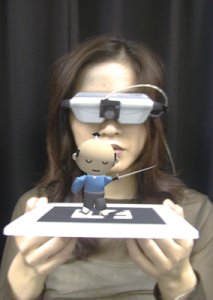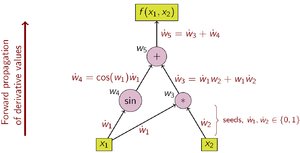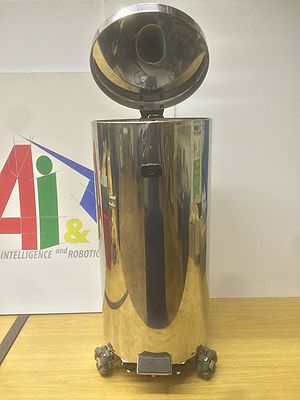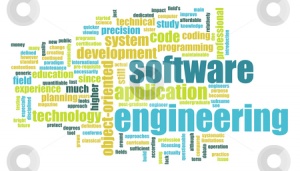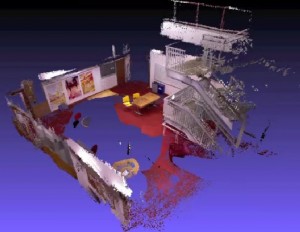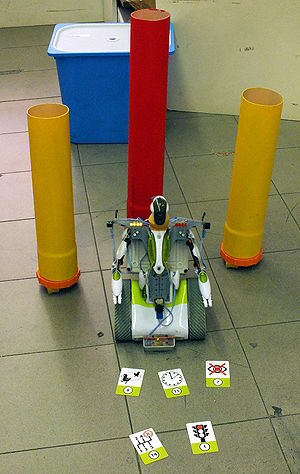Difference between revisions of "2nd Level Theses"
m |
|||
| Line 2: | Line 2: | ||
<!--==== Evolutionary Optimization and Stochastic Optimization ====--> | <!--==== Evolutionary Optimization and Stochastic Optimization ====--> | ||
| − | ==== Agents, Multiagent Systems, Agencies ==== | + | <!--==== Agents, Multiagent Systems, Agencies ====--> |
| − | {{#ask: [[Category:ProjectProposal]] | + | {{#ask: [[Category:ProjectProposal]] [[PrjStatus::Active]] |
[[PrjResArea::Agents, Multiagent Systems, Agencies]] | [[PrjResArea::Agents, Multiagent Systems, Agencies]] | ||
[[PrjLevel::Ms]] | [[PrjLevel::Ms]] | ||
| Line 24: | Line 24: | ||
<!--==== BioSignal Analysis ====--> | <!--==== BioSignal Analysis ====--> | ||
| − | ===== Brain-Computer Interface ===== | + | <!--===== Brain-Computer Interface =====--> |
{{#ask: [[Category:ProjectProposal]] | {{#ask: [[Category:ProjectProposal]] | ||
| − | [[PrjResArea::BioSignal Analysis]] | + | [[PrjResArea::BioSignal Analysis]] [[PrjStatus::Active]] |
[[PrjResTopic::Brain-Computer Interface]] | [[PrjResTopic::Brain-Computer Interface]] | ||
[[PrjLevel::Ms]] | [[PrjLevel::Ms]] | ||
| Line 48: | Line 48: | ||
<!--==== Computer Vision and Image Analysis ====--> | <!--==== Computer Vision and Image Analysis ====--> | ||
<!--==== E-Science ====--> | <!--==== E-Science ====--> | ||
| − | ==== Machine Learning ==== | + | <!--==== Machine Learning ====--> |
| − | {{#ask: [[Category:ProjectProposal]] | + | {{#ask: [[Category:ProjectProposal]] [[PrjStatus::Active]] |
[[PrjResArea::Machine Learning]] | [[PrjResArea::Machine Learning]] | ||
[[PrjLevel::Ms]] | [[PrjLevel::Ms]] | ||
| Line 71: | Line 71: | ||
| − | ==== Computational Intelligence and Games ==== | + | <!--==== Computational Intelligence and Games ====--> |
| − | {{#ask: [[Category:ProjectProposal]] | + | {{#ask: [[Category:ProjectProposal]] [[PrjStatus::Active]] |
[[PrjResArea::Computational Intelligence and Games]] | [[PrjResArea::Computational Intelligence and Games]] | ||
[[PrjLevel::Ms]] | [[PrjLevel::Ms]] | ||
| Line 94: | Line 94: | ||
| − | ==== Social Software and Semantic Web ==== | + | <!--==== Social Software and Semantic Web ====--> |
| − | {{#ask: [[Category:ProjectProposal]] | + | {{#ask: [[Category:ProjectProposal]] [[PrjStatus::Active]] |
[[PrjResArea::Social Software and Semantic Web]] | [[PrjResArea::Social Software and Semantic Web]] | ||
[[PrjLevel::Ms]] | [[PrjLevel::Ms]] | ||
| Line 119: | Line 119: | ||
==== Robotics ==== | ==== Robotics ==== | ||
| − | {{#ask: [[Category:ProjectProposal]] | + | {{#ask: [[Category:ProjectProposal]] [[PrjStatus::Active]] |
[[PrjResArea::Robotics]] | [[PrjResArea::Robotics]] | ||
[[PrjLevel::Ms]] | [[PrjLevel::Ms]] | ||
Revision as of 17:16, 28 April 2011
Here you can find proposals for master thesis (20 CFU for each student). See Project Proposals for other kinds of projects and theses.
| Wiki Page: | 3D Scene Understanding | |
| Title: | 3D Indoor scene understanding and layout reconstruction for a mobile robot in collaboration with UnimiB | |
| Description: | The proposed project aims to reconstruct the 3D structural layout of an indoor environment perceived by a mobile robot. From the sensorial data, the robot should be able to reconstruct a geometrical structure of an indoor environment (e.g., an office).
Methods for indoor layout reconstruction must be significantly more tolerant to missing data than their outdoor counterparts, since environments such as offices and apartments exhibit extremely high levels of clutter, which typically results in heavy occlusions of walls and other structures of interest, large-scale artifacts, noise and missing data. The proposed work will be developed in collaboration with IRALAB, the Robotics Lab of University of Milano Bicocca. The work will be based on an existing project, Free Your Camera (http://www.ira.disco.unimib.it/research/robotic-perception-research/free-your-camera-3d-indoor-scene-understanding-from-arbitrary-camera-motion/) and will be part of a robotic framework based on with ROS and in development at IRALAB. | |
| Tutor: | [[FrancescoAmigoni | ]] (, , , , , , , , , , , , , , , , , , … further resultswarning.png
| |
| Start: | 1 February 2015 | |
| Students: | 1 - 2 | |
| CFU: | 10 - 20 | |
| Research Area: | Robotics | |
| Research Topic: | Robotics |
| Wiki Page: | Accurate AR Marker Location | |
| Title: | C++ Library for accurate marker location based on subsequent pnp refinements | |
| Description: | ARTags, QR codes, Data Matrix, are visual landmark used for augmented reality, but they could be used for robotics as well. A thesis has already been done on using data matrix for robot localization and mapping, but improvements are required in terms generality, accuracy and robustness of the solution. The goal is thuss to:
Material:
Expected outcome:
Required skills or skills to be acquired:
| |
| Tutor: | [[MatteoMatteucci | ]] (, , , , , , , , , , , , , , , , , , … further resultswarning.png
| |
| Start: | 1 January 2015 | |
| Students: | 1 - 2 | |
| CFU: | 5 - 10 | |
| Research Area: | Computer Vision and Image Analysis | |
| Research Topic: | None |
| Wiki Page: | Automatic Differentiation Techniques for Real Time Kalman Filtering | |
| Title: | Evaluation of Automatic Differentiation Techniques for Gauss-Newton based Simultaneous Localization and Mapping | |
| Description: | In Gauss-Newton non linear optimization one of the most tedious part is computing Jacobians. At the AIRLab we have developed a framework for non linear Simultaneous Localization and Mapping suitable for different motion models and measurement equations, but any time you need to change something you need to recompute the required Jacobian. Automatic differentiation is a tool for the automatic differentiation of source code either at compiling time or at runtime; we are interested in testing these techniques in the software we have developed and compare their performance with respect to (cumbersome) optimized computation.
Material
Expected outcome: New modules implementations based on automatic differentiation A comparison between the old stuff and new approach Required skills or skills to be acquired:
| |
| Tutor: | [[MatteoMatteucci | ]] (, , , , , , , , , , , , , , , , , , … further resultswarning.png
| |
| Start: | 1 January 2015 | |
| Students: | 1 - 2 | |
| CFU: | 10 - 20 | |
| Research Area: | Robotics | |
| Research Topic: | None |
| Wiki Page: | Cognitive SLAM | |
| Title: | Cognitive SLAM | |
| Description: | We have developed a system that is able to detect, recognize and track objects in an image taken from a low cost robot equipped with a IMU and a low cost camera. The system is capable to detect and recognize objects using a user defined fuzzy tree classifier. However the system performance is heavily dependent on high level feature extraction, such as geometric features. The problem is non trivial due to noisy low cost camera and changes in the light conditions. The aim of this project is to improve the feature extraction and description process, both in performance and quality, possible adding a more complete description or others type of features. The long term aim of the research is to have an autonomuos robot capable to create a semantic map of the envirorment, localize himself , make inference on the map, navigate into the envirorment using the objects as landmarks.
No special skills are required, except basic c and object oriented programming. | |
| Tutor: | [[AndreaBonarini | ]] (, , , , , , , , , , , , , , , , , , … further resultswarning.png
| |
| Start: | 1 January 2015 | |
| Students: | 1 - 2 | |
| CFU: | 5 - 20 | |
| Research Area: | Robotics | |
| Research Topic: | SLAM, Feature Extraction |
| Wiki Page: | Comparison of State of the Art Visual Odometry Systems | |
| Title: | A Comparison of State of the Art Visual Odometry Systems (Monocular and Stereo) | |
| Description: | Visual odometry is the estimation of camera(s) movement from a sequence of images. In case we deal with a single camera system we have Monocular Visual Odometry; in case we have more cameras we have a Stero Visual Odometry. The goal of the thesis is to review the state of the art on in visual odometry, classify existing approaches and compare their implementations (many of the algorithms have online source code available).
Material
Expected outcome:
Required skills or skills to be acquired:
| |
| Tutor: | [[MatteoMatteucci | ]] (, , , , , , , , , , , , , , , , , , … further resultswarning.png
| |
| Start: | 1 January 2015 | |
| Students: | 1 - 2 | |
| CFU: | 10 - 20 | |
| Research Area: | Computer Vision and Image Analysis | |
| Research Topic: | None |
| Wiki Page: | Designing Living Objects | |
| Title: | Designing Living Objects | |
| Description: | The aim of this activity is to investigate how one or more objects in an antropic environment (home, office, hospital) can be designed and implemented to have a character and to move, having nice interactions with people. The work to be done concerns the analysis, definition, design and implementation of at least one of these objects. | |
| Tutor: | [[AndreaBonarini | ]] (, , , , , , , , , , , , , , , , , , … further resultswarning.png
| |
| Start: | 15 October 2017 | |
| Students: | 1 - 2 | |
| CFU: | 5 - 20 | |
| Research Area: | Robotics | |
| Research Topic: | Living Objects |
| Wiki Page: | Mesh Refinement with Deep Learning | |
| Title: | Mesh Refinement with Deep Learning | |
| Description: | Mesh Refinement with Deep Learning | |
| Tutor: | [[AndreaRomanoni | ]] (, , , , , , , , , , , , , , , , , , … further resultswarning.png
| |
| Start: | October 2018 | |
| Students: | 1 | |
| CFU: | 5 | |
| Research Area: | Computer Vision and Image Analysis |
| Wiki Page: | MoonSLAM Reengineering | |
| Title: | Reengineering of a flexible framework for simultaneous localization and mapping | |
| Description: | In the last three years a general framework for the implementation of EKF-SLAM algorithm has been developed at the AIRLab. After several improvements it is now time to redesign it based on the experience cumulated. The goal is to have an international reference framework for the development of EKF based SLAM algorithms with multiple sensors (e.g., lasers, odometers, inertial measurement ) and different motion models (e.g., free 6DoF motion, planar motion, ackerman kinematic, and do on). The basic idea is to implement it by using C++ templates, numerically stable techniques for Kalman filtering and investigation the use of automatic differentiation. It should be possible to seamlessly exchange motion model and sensor model without having to write code beside the motion model and the measurement equation.
Material
Expected outcome:
Required skills:
| |
| Tutor: | [[MatteoMatteucci | ]] (, , , , , , , , , , , , , , , , , , … further resultswarning.png
| |
| Start: | 1 January 2015 | |
| Students: | 1 - 2 | |
| CFU: | 20 - 20 | |
| Research Area: | Robotics | |
| Research Topic: | None |
| Wiki Page: | Poit cloud SLAM with Microsoft Kinect | |
| Title: | Point cloud SLAM with Microsoft Kinect | |
| Description: | Simultaneous Localization and Mapping (SLAM) is one of the basic functionalities required from an autonomous robot. In the past we have developed a framework for building SLAM algorithm based on the use of the Extended Kalman Filter and vision sensors. A recently available vision sensor which has tremendous potential for autonomous robots is the Microsoft Kinect RGB-D sensor. The thesis aims at the integration of the Kinect sensor in the framework developed for the development of a point cloud base system for SLAM.
Material:
Expected outcome:
Required skills or skills to be acquired:
| |
| Tutor: | [[MatteoMatteucci | ]] (, , , , , , , , , , , , , , , , , , … further resultswarning.png
| |
| Start: | 1 January 2015 | |
| Students: | 1 - 2 | |
| CFU: | 10 - 20 | |
| Research Area: | Computer Vision and Image Analysis | |
| Research Topic: | None |
| Wiki Page: | ROS navigation local planner | |
| Title: | ROS_navigation_local_planner | |
| Description: | The project will be focused on the implementation of a planner and tracking algorithms for Ackermann vehicles | |
| Tutor: | {{EmailViz|1=[[:User:MatteoMatteucci}}, MatteoMatteucci (), [[]] | ]] (, , , , , , , , , , , , , , , , , , … further resultswarning.png
| |
| Start: | October 2017 | |
| Students: | 1 - 3 | |
| CFU: | 2 - 20 | |
| Research Area: | Robotics | |
| Research Topic: | Local Planner |
| Wiki Page: | Robot Games | |
| Title: | Robot Games | |
| Description: | Projects may include the design of an interactive game on an existing or a new robot, and its evaluation. These projects allow to experiment with real mobile robots and interaction devices. Some games may be designed for disabled children. The project can be considered a MS thesis if it can produce a new game and, possibly, a new robot, and includes adapting the behavior of the robot to the player. | |
| Tutor: | [[AndreaBonarini | ]] (, , , , , , , , , , , , , , , , , , … further resultswarning.png
| |
| Start: | ||
| Students: | 1 - 2 | |
| CFU: | 2 - 20 | |
| Research Area: | Robotics | |
| Research Topic: | Robogames |
| Wiki Page: | Unmanned Aerial Vehicles Visual Navigation | |
| Title: | A critical review on the state of the art in visual navigation for unmanned aerial vehicles | |
| Description: | Visual navigation is becoming more and more important in the development of unmanned aerial vehicles (UAV). The goal of this thesis/tesina is to review in a structured way the current state of art in the field from different perspective: research teams, projects, platforms, tasks, algorithms. The latter is the most important aspect obviously and the project should provide a clear view on what is done today, and obtaining which results. Two kind of operations are of most interest: tracking of fixed and mobile targets (and how this impact on the UAV path), navigation on a geo-referenced map. Implementing one of the standard approaches on a mini unmanned aerial vehicle would be the ideal ending of the work to turn it into a thesis.
Material:
Expected outcome:
Required skills or skills to be acquired:
| |
| Tutor: | [[MatteoMatteucci | ]] (, , , , , , , , , , , , , , , , , , … further resultswarning.png
| |
| Start: | 1 January 2015 | |
| Students: | 1 - 2 | |
| CFU: | 10 - 20 | |
| Research Area: | Robotics | |
| Research Topic: | None |
warning.png"Agents, Multiagent Systems, Agencies" is not in the list of possible values (Affective Computing, Agents - Multiagent Systems - Agencies, BioSignal Analysis, Computational Intelligence and Games, Computer Vision and Image Analysis, E-Science, Machine Learning, Philosophy of Artificial Intelligence, Robotics, Social Software and Semantic Web) for this property.
Robotics
| Wiki Page: | 3D Scene Understanding | |
| Title: | 3D Indoor scene understanding and layout reconstruction for a mobile robot in collaboration with UnimiB | |
| Description: | The proposed project aims to reconstruct the 3D structural layout of an indoor environment perceived by a mobile robot. From the sensorial data, the robot should be able to reconstruct a geometrical structure of an indoor environment (e.g., an office).
Methods for indoor layout reconstruction must be significantly more tolerant to missing data than their outdoor counterparts, since environments such as offices and apartments exhibit extremely high levels of clutter, which typically results in heavy occlusions of walls and other structures of interest, large-scale artifacts, noise and missing data. The proposed work will be developed in collaboration with IRALAB, the Robotics Lab of University of Milano Bicocca. The work will be based on an existing project, Free Your Camera (http://www.ira.disco.unimib.it/research/robotic-perception-research/free-your-camera-3d-indoor-scene-understanding-from-arbitrary-camera-motion/) and will be part of a robotic framework based on with ROS and in development at IRALAB. | |
| Tutor: | [[FrancescoAmigoni | ]] (, , , , , , , , , , , , , , , , , , … further resultswarning.png
| |
| Start: | 1 February 2015 | |
| Students: | 1 - 2 | |
| CFU: | 10 - 20 | |
| Research Area: | Robotics | |
| Research Topic: | Robotics |
| Wiki Page: | Automatic Differentiation Techniques for Real Time Kalman Filtering | |
| Title: | Evaluation of Automatic Differentiation Techniques for Gauss-Newton based Simultaneous Localization and Mapping | |
| Description: | In Gauss-Newton non linear optimization one of the most tedious part is computing Jacobians. At the AIRLab we have developed a framework for non linear Simultaneous Localization and Mapping suitable for different motion models and measurement equations, but any time you need to change something you need to recompute the required Jacobian. Automatic differentiation is a tool for the automatic differentiation of source code either at compiling time or at runtime; we are interested in testing these techniques in the software we have developed and compare their performance with respect to (cumbersome) optimized computation.
Material
Expected outcome: New modules implementations based on automatic differentiation A comparison between the old stuff and new approach Required skills or skills to be acquired:
| |
| Tutor: | [[MatteoMatteucci | ]] (, , , , , , , , , , , , , , , , , , … further resultswarning.png
| |
| Start: | 1 January 2015 | |
| Students: | 1 - 2 | |
| CFU: | 10 - 20 | |
| Research Area: | Robotics | |
| Research Topic: | None |
| Wiki Page: | Cognitive SLAM | |
| Title: | Cognitive SLAM | |
| Description: | We have developed a system that is able to detect, recognize and track objects in an image taken from a low cost robot equipped with a IMU and a low cost camera. The system is capable to detect and recognize objects using a user defined fuzzy tree classifier. However the system performance is heavily dependent on high level feature extraction, such as geometric features. The problem is non trivial due to noisy low cost camera and changes in the light conditions. The aim of this project is to improve the feature extraction and description process, both in performance and quality, possible adding a more complete description or others type of features. The long term aim of the research is to have an autonomuos robot capable to create a semantic map of the envirorment, localize himself , make inference on the map, navigate into the envirorment using the objects as landmarks.
No special skills are required, except basic c and object oriented programming. | |
| Tutor: | [[AndreaBonarini | ]] (, , , , , , , , , , , , , , , , , , … further resultswarning.png
| |
| Start: | 1 January 2015 | |
| Students: | 1 - 2 | |
| CFU: | 5 - 20 | |
| Research Area: | Robotics | |
| Research Topic: | SLAM, Feature Extraction |
| Wiki Page: | Designing Living Objects | |
| Title: | Designing Living Objects | |
| Description: | The aim of this activity is to investigate how one or more objects in an antropic environment (home, office, hospital) can be designed and implemented to have a character and to move, having nice interactions with people. The work to be done concerns the analysis, definition, design and implementation of at least one of these objects. | |
| Tutor: | [[AndreaBonarini | ]] (, , , , , , , , , , , , , , , , , , … further resultswarning.png
| |
| Start: | 15 October 2017 | |
| Students: | 1 - 2 | |
| CFU: | 5 - 20 | |
| Research Area: | Robotics | |
| Research Topic: | Living Objects |
| Wiki Page: | MoonSLAM Reengineering | |
| Title: | Reengineering of a flexible framework for simultaneous localization and mapping | |
| Description: | In the last three years a general framework for the implementation of EKF-SLAM algorithm has been developed at the AIRLab. After several improvements it is now time to redesign it based on the experience cumulated. The goal is to have an international reference framework for the development of EKF based SLAM algorithms with multiple sensors (e.g., lasers, odometers, inertial measurement ) and different motion models (e.g., free 6DoF motion, planar motion, ackerman kinematic, and do on). The basic idea is to implement it by using C++ templates, numerically stable techniques for Kalman filtering and investigation the use of automatic differentiation. It should be possible to seamlessly exchange motion model and sensor model without having to write code beside the motion model and the measurement equation.
Material
Expected outcome:
Required skills:
| |
| Tutor: | [[MatteoMatteucci | ]] (, , , , , , , , , , , , , , , , , , … further resultswarning.png
| |
| Start: | 1 January 2015 | |
| Students: | 1 - 2 | |
| CFU: | 20 - 20 | |
| Research Area: | Robotics | |
| Research Topic: | None |
| Wiki Page: | ROS navigation local planner | |
| Title: | ROS_navigation_local_planner | |
| Description: | The project will be focused on the implementation of a planner and tracking algorithms for Ackermann vehicles | |
| Tutor: | {{EmailViz|1=[[:User:MatteoMatteucci}}, MatteoMatteucci (), [[]] | ]] (, , , , , , , , , , , , , , , , , , … further resultswarning.png
| |
| Start: | October 2017 | |
| Students: | 1 - 3 | |
| CFU: | 2 - 20 | |
| Research Area: | Robotics | |
| Research Topic: | Local Planner |
| Wiki Page: | Robot Games | |
| Title: | Robot Games | |
| Description: | Projects may include the design of an interactive game on an existing or a new robot, and its evaluation. These projects allow to experiment with real mobile robots and interaction devices. Some games may be designed for disabled children. The project can be considered a MS thesis if it can produce a new game and, possibly, a new robot, and includes adapting the behavior of the robot to the player. | |
| Tutor: | [[AndreaBonarini | ]] (, , , , , , , , , , , , , , , , , , … further resultswarning.png
| |
| Start: | ||
| Students: | 1 - 2 | |
| CFU: | 2 - 20 | |
| Research Area: | Robotics | |
| Research Topic: | Robogames |
| Wiki Page: | Unmanned Aerial Vehicles Visual Navigation | |
| Title: | A critical review on the state of the art in visual navigation for unmanned aerial vehicles | |
| Description: | Visual navigation is becoming more and more important in the development of unmanned aerial vehicles (UAV). The goal of this thesis/tesina is to review in a structured way the current state of art in the field from different perspective: research teams, projects, platforms, tasks, algorithms. The latter is the most important aspect obviously and the project should provide a clear view on what is done today, and obtaining which results. Two kind of operations are of most interest: tracking of fixed and mobile targets (and how this impact on the UAV path), navigation on a geo-referenced map. Implementing one of the standard approaches on a mini unmanned aerial vehicle would be the ideal ending of the work to turn it into a thesis.
Material:
Expected outcome:
Required skills or skills to be acquired:
| |
| Tutor: | [[MatteoMatteucci | ]] (, , , , , , , , , , , , , , , , , , … further resultswarning.png
| |
| Start: | 1 January 2015 | |
| Students: | 1 - 2 | |
| CFU: | 10 - 20 | |
| Research Area: | Robotics | |
| Research Topic: | None |

